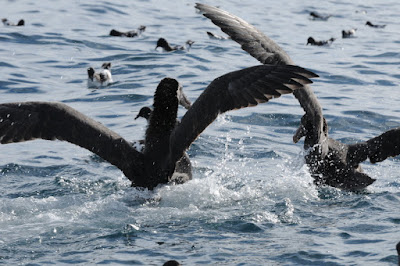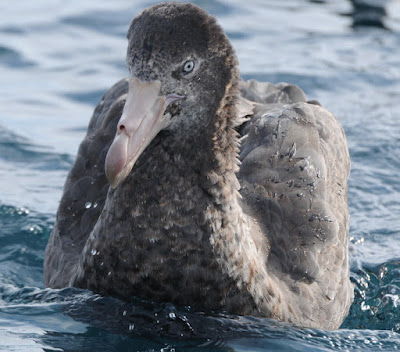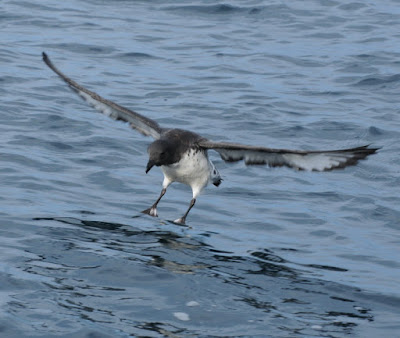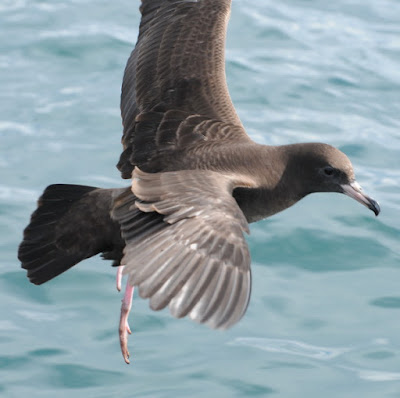The albatrosses at Kaikoura are the star bird attractions, but the petrels and shearwaters can be just as fascinating. Here's one of each, going at the chum bag on my Albatross Encounters pelagic: a Cape Petrel (Daption capense) and a Flesh-footed Shearwater (Puffinus carneipes).
Buy far the largest of the lot are the giant petrels, also known as stinkers (they are scavengers, and will gladly dine on sewage). There are to species, best distinguished by the colour of the bill tip.
At Kaikoura we saw only Northern Giant Petrels (Macronectes halli), with a reddish tip to the bill (the Southern Giant Petrel (M. giganteus), which can be numerous here at times, has a greenish bill-tip). Immatures are much darker and plainer than adults. Though quite a bit smaller than albatrosses, they are still formidable birds.
In flight they appear much stockier than albatrosses, and seem to have to work quite hard to get off the water.
Giant Petrels can be extremely aggressive....
...and at close range, they look it (perhaps it's the white irides).
The Cape Petrel is a much gentler-looking bird (it is often called the Cape Pigeon, and it does have a soft, rather dove-like look)...
...not that this is any guide to its personality - it can squabble with the best of them, and is very noisy. The famous pioneer seabird ornithologist Robert Cushman Murphy noted that the Cape Petrel "seems to dislike to see another eating as much
as it enjoys the process itself"!
Their motley charcoal-and-white plumage makes Cape Petrels easy to identify - more than you can say for most of their relatives! Note the breadth of the bill in the upper photograph.
Their pattern - responsible for another of their names, "pintado" - is most attractive in flight. These are very pretty, if voracious, little birds.
Identifying petrels of the genus Procellaria is complicated by the fact that New Zealand has three species with practically identical plumage - all, or mostly all, deep brownish grey to black. Fortunately I had only two of them to worry about at Kaikoura. This is the first: the White-chinned Petrel (P. aequinoctialis).
Yes, it does have a little dab of white under the bill (usually), but that's a pretty risky field mark.
A better clue to the White-chinned's identity is the pale tip to the bill. Of course, having the birds at close range helps!
A better clue to the White-chinned's identity is the pale tip to the bill. Of course, having the birds at close range helps!
The White-chinned Petrel is a wide-ranging bird; I had seen it before in South Africa, where it is both common and the only black Procellaria around, and off Peru.
The other Kaikoura species, the Westland Petrel (Procellaria westlandica), is much more of a local specialty, breeding only near Punakaiki on the west coast of the South Island (though at sea it ranges to Australia across the Pacific to South America). Its population is much smaller, an estimated 20,000 birds compared to seven million!
It strikes me as a bit on the chunky side, but the best identifying mark is the black, rather than yellowish-horn, tip to the bill.
Barring an extremely poor and doubtful glimpse off Peru in 2006, it was a life bird for me, and one I was particularly happy to see so well.
The Westland Petrel was once considered to be at serious risk,and is still a matter of conservation concern though its numbers have increased. Introduced predators threaten on its breeding grounds, and tuna longliners catch them at sea (a problem facing many seabirds in the souhern oceans).
Just to complicate matters, we had a third all-blackish-brown species at Kaikoura: the Flesh-footed Shearwater (Puffinus carneipes). It is a slimmer bird than the Procellaria petrels, with a thin, largely pinkish-flesh (rather than yellowish-horn) bill.
Of course if you can see the flesh-pink feet, identification is no problem at all.
Of the three species of shearwater we saw off Kaikoura the most attractive is surely Buller's Shearwater (Puffinus bulleri) (the third species, Hutton's Shearwater (P. huttoni), is not attracted to chum, and I had to be content with views of them flying past in the distance).
The crisp white underparts and blackish "W" pattern on the upperside of the wings are the key field marks.
Though it has a population of some 2.5 milion birds, Buller's has a very restricted breeding distribution at the northern and southern ends of New Zealand. It migrates widely across the Pacific - I once had a distant glimpse of one from the California coast.
Buller's Shearwater is not a large bird (as this comparison with a Kelp Gull (Larus dominicanus) shows), but it is a most attractive one. Like all the birds I saw off Kaikoura, it was exciting for a northern-hemisphere inland-dweller to see.


















































No comments:
Post a Comment